- Quick Read
- Deep Read ( 13 Min. )

Why is Christian Science in our name?
Our name is about honesty. The Monitor is owned by The Christian Science Church, and we’ve always been transparent about that.
The Church publishes the Monitor because it sees good journalism as vital to progress in the world. Since 1908, we’ve aimed “to injure no man, but to bless all mankind,” as our founder, Mary Baker Eddy, put it.
Here, you’ll find award-winning journalism not driven by commercial influences – a news organization that takes seriously its mission to uplift the world by seeking solutions and finding reasons for credible hope.
Explore values journalism About usIn Today’s Issue
Monitor Daily Podcast
- Follow us:
- Apple Podcasts
- Spotify
- RSS Feed
- Download
TODAY’S INTRO
Who is responsible for climate change?
 Mark Sappenfield
Mark Sappenfield
What stands out to me about today’s story by Taylor Luck and Erika Page is how effectively they explore the matter of responsibility in climate change. They avoid the scolding tone or simplistic blame game that so often tempts the media. But their story raises hard questions. In Tunisia, families desperate to stay in the rural communities they love are no longer able to eke out a living from the parched dirt.
Who is responsible for fixing that?
Climate change is a new kind of challenge, because the responsibility is collective and the solution is collective. There is no lack of ways forward. But they all begin with a more honest sense of responsibility, both as individuals and in a way that transcends borders.
Share this article
Link copied.

Help fund Monitor journalism for $11/ month
Already a subscriber? Login

Monitor journalism changes lives because we open that too-small box that most people think they live in. We believe news can and should expand a sense of identity and possibility beyond narrow conventional expectations.
Our work isn't possible without your support.
A deeper look
What a Tunisian exodus says about the future of global migration
In an age of global migration, Tunisia offers a window into key stressors driving migrants from their homes: political instability, inequality, and climate change.

-
Erika Page Staff writer
Salih Barqoushi thinks of home in Al-Ala, Tunisia, as his “paradise.”
“It is the most beautiful land,” he says of the village where he was born and, until recently, lived and farmed with his wife and family.
The first setback came in 2014 when the rains stopped. By 2017, his vegetables were requiring year-round irrigation and production was halved. After trying his hand at low-paying jobs in the village, he decided he needed to seek work in the capital, Tunis, 125 miles away.
Now, he works as a construction day laborer painting buildings and sleeps in the corner of a friend’s vegetable stall in Tunis. His wife, Sonia, keeps the family farm alive – but not producing.
It’s a common story told across the country. But Tunisia is not unique, experts caution. What is happening here, they say, is the future of world migration.
Around the world, a trio of global crises – political instability, inequality, and climate change – is increasingly driving families from homes, villages, and even countries.
“Tunisia is emblematic of global trends,” says Lawrence Huang, policy analyst at the Washington-based Migration Policy Institute.
Here, as in elsewhere, young people are leaving in droves.
“No one would give up farming for that life by choice,” says Issa Idoudi, a local Tunisian farmers union representative. “These people have no money, no options. They were forced out.”
What a Tunisian exodus says about the future of global migration
When he clings to the outside of a fourth-story apartment, applying another coat of white paint under the glare of Tunis’ sun, or when he lies on his cot in the dark corner of an urban vegetable stand, Salih Barqoushi thinks of home, his “paradise.”
It is so vivid, he can almost touch it. Walls of prickly pear cactus reach 7 feet high. Rolling hills of millennial olive and almond trees flex their knotted branches. Echoes of laughing children bounce across the fertile blood-red soil. Chickens and quails scurry about, all under a low-hung, bright-blue sky that seems to never end.
“It is the most beautiful land; it was the most beautiful life,” Mr. Barqoushi says as he lingers near a Tunis train station hoping to be picked up for a job. His village is called Al-Ala, Arabic for “the highest.”
Mr. Barqoushi had the highest of hopes in early 2011, like many Tunisians, when a democratic revolution demanding “dignity, social justice” ended decades of dictatorship. The new popularly elected assembly vowed to lift up rural communities after the ousting of authoritarian strongman President Zine el-Abidine Ben Ali, who for nearly 25 years directed resources away from Tunisia’s rural interior to its coastal cities. At last, farmers like Mr. Barqoushi could more than get by; they could flourish.
He married and moved into the house he was born in and bought a dozen sheep to produce milk and cheese. He rolled up his sleeves to expand his family’s rain-fed olive farm with crops such as bell peppers and tomatoes, wheat and barley.
“We thought our lives would get better,” he says.
The first setback came in 2014 when the rains stopped. His barley and wheat dried up, forcing him to purchase animal feed for his flock. After two years of rising feed prices, he was forced to sell off his sheep. By 2017, his vegetables were requiring year-round irrigation, costing more than $450 dinars, about $150, per month, and production was halved. After trying his hand at low-paying jobs in the village, scraping $8 a day, he decided he needed to leave his home, farm, wife, and children to relocate to the capital, Tunis, 125 miles away. He works as a construction day laborer painting buildings. On a good day, he earns $16 for 10 hours of work.
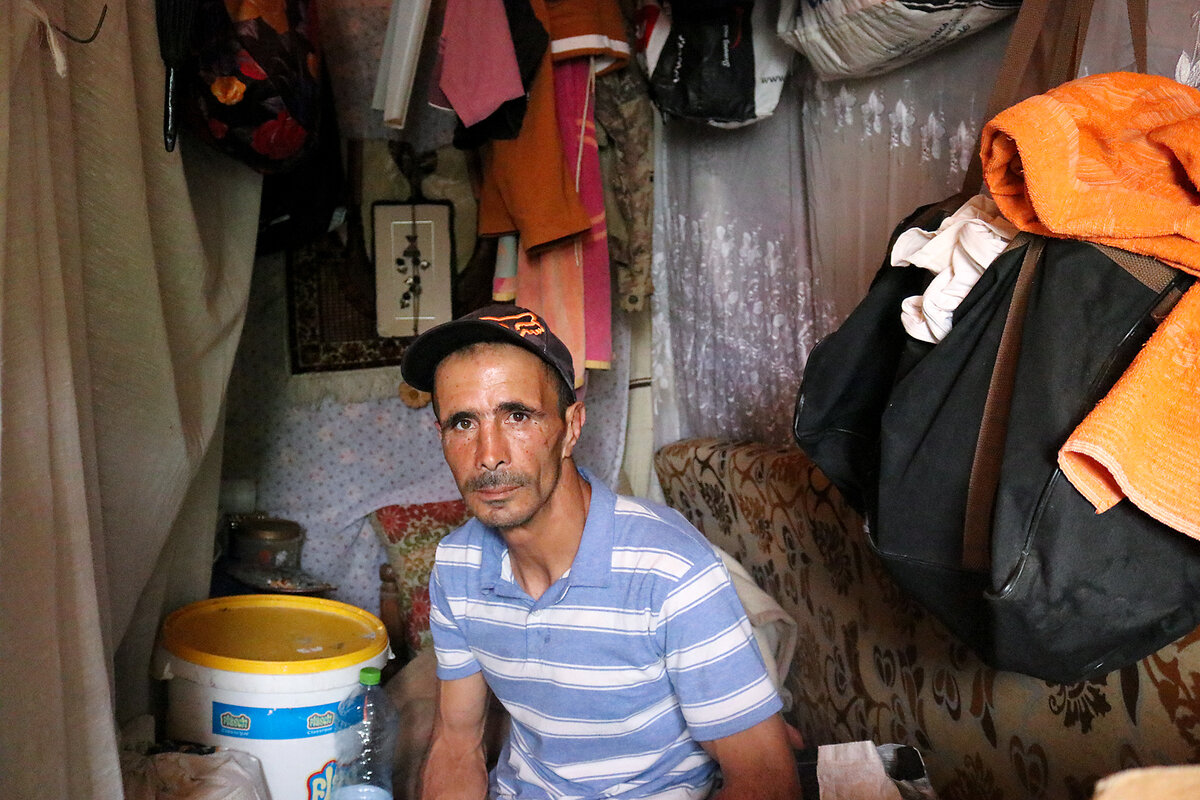
Mr. Barqoushi is singularly focused on what he believes is the only path to returning home, reuniting with his family, revitalizing his farm, and reversing his fortunes – a path that runs 100 meters below the earth.
If only he could tap the receding underground aquifer, he says, he could make his farm thrive.
“I wouldn’t leave my home for a single day if I had water. All I need is a well,” he says, shaking his head. “If I only had a well.”
At the current rate, it would take Mr. Barqoushi over a decade to save up the $10,000 needed to dig a 100-meter (330-foot) well.
Climate is just one factor driving migrants from their homes
Around the world, a trio of global crises – political instability, inequality, and climate change – is increasingly driving families from homes, villages, and even countries.
Although statistics on migration are complicated, the United Nations estimates that 281 million people live in a country other than that of their birth, 128 million more than 30 years ago. Hundreds of millions more are like Mr. Barqoushi, moving within borders to try to provide for loved ones.
The causes of this mass movement of humans are intertwined and, like the statistics themselves, complicated. They are also accelerating. The share of refugees and asylum-seekers from regions threatened by climate change, for instance, has jumped from 61% in 2010 to 84% in 2022, according to the United Nations refugee agency.
In few places can one observe this collision as clearly as in Tunisia. Here, in this Mediterranean African country, people are experiencing the autocratic relapse of the world’s youngest democracy, hyperinflation thanks to decades-old economic mismanagement, and temperatures warming at twice the global rate, coupled with historic drought.
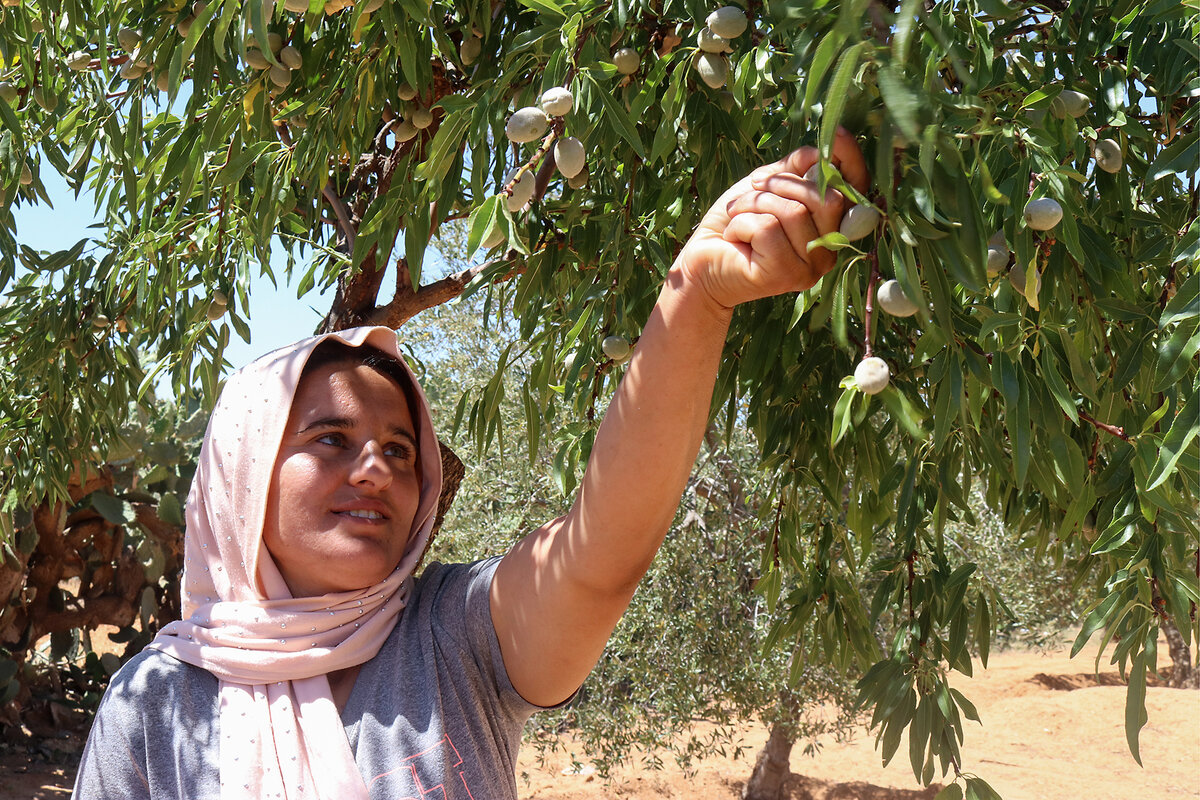
But Tunisia is not unique, experts caution. What is happening here, they say, is the future of world migration.
“Tunisia is not an anomaly by any means, globally or within the region,” says Brendan Kelly, head of the migration and development unit at the International Organization for Migration in Tunisia. He cites the country’s water stress, more frequent and longer heat waves, a drop in precipitation – which is expected to drop 10% to 35% further by 2050 – and lack of economic opportunity pushing more and more Tunisians to leave their hometowns and villages.
“In Tunisia we are already seeing [how] the extremely serious consequences of climate change and environmental degradation, combined with economic factors, drive human mobility,” he says. “The projections for the next decades to come are even more serious.”
Severe drought leaves Tunisian farmers with few choices
Brahim Al Hur’s farms sit on either side of the invisible dividing line that cuts the town of Sisseb into two parts: bone-dry and going dry.
The arid climate, cool evenings, and fertile soil once made this region a breadbasket. Recently, it has been so dry that authorities have restricted agricultural water use by 50% in order to make sure residents have enough to drink.
Mr. Al Hur steps between the few scant, yellowing shrubs that are now his northern farm, kicking up dust for effect. This is the bone-dry side of town. It would cost thousands of dollars per year to pump in water from outside and $20,000 to dig a well deep enough to reach the aquifer. He frowns and shakes his head: It’s not worth the trouble.
Instead, Mr. Al Hur is throwing himself into saving his farm on the southern side of town. But his house and 2 acres there are still on the front lines of the encroaching drought. A series of thick black rubber pipes running from a well a mile outside town provides a trickle of water to his brittle olive trees. His father planted them 50 years ago; today, Mr. Al Hur can provide enough water to keep them alive, but not enough to get olives. A 100-meter well went dry four years ago. In 2022, he spent $6,500 to dig a new, deeper 200-meter well. Now that, too, is dry.
Mr. Al Hur grabs a fistful of yellowed leaves off one of the trees and crunches them in his hand.
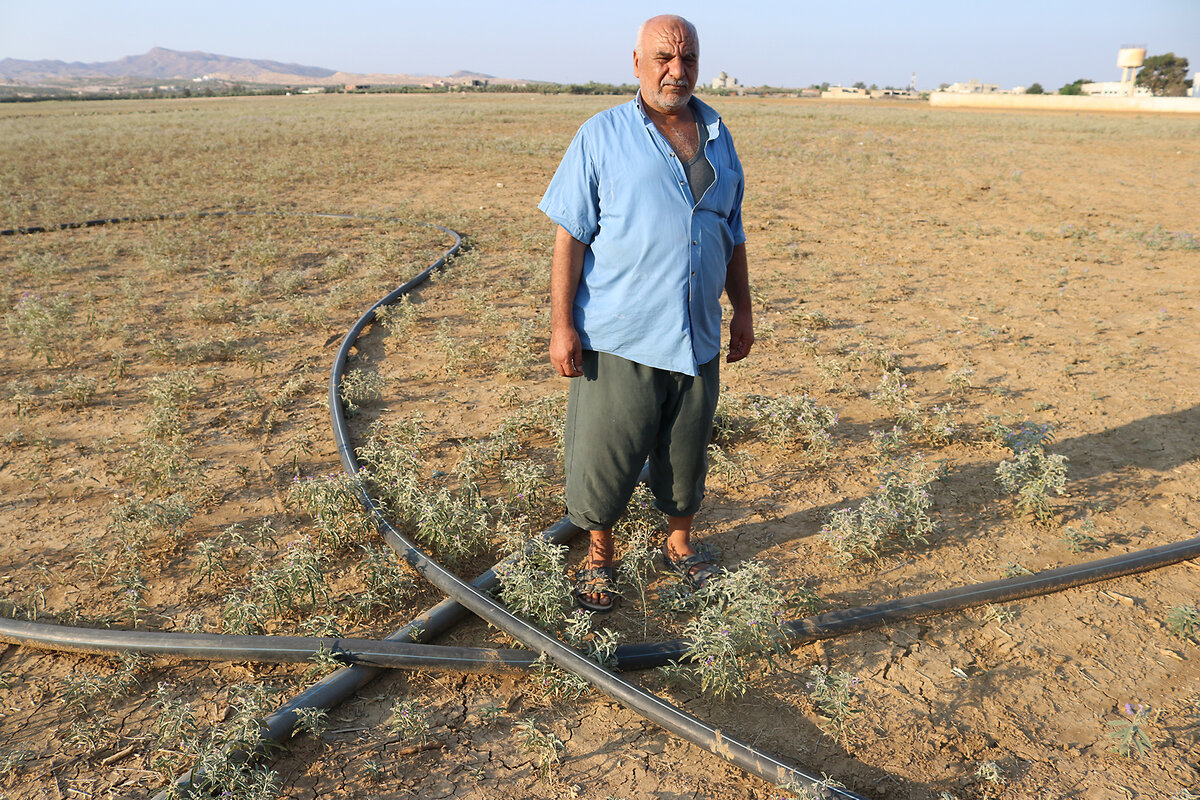
“You see?” he says. “Even when we irrigate, it is still not enough to keep up with the hot temperatures. Our trees need more water than ever before at a time our water has never been less.”
He had wanted his son, Seifaldin, to join him in farming.
In 2022, Mr. Al Hur bought his son a truck, built him an apartment attached to the family home, and paid for his wedding. Mr. Al Hur hoped this would all help Seifaldin resist the allure drawing young Tunisian men to Europe.
But in July 2023, the younger Mr. Al Hur told his parents that he and his new wife would attend a friend’s wedding in Kasserine, 120 miles away, and would spend three nights in the town. He never came home.
One week later, a worried Mr. Al Hur received a phone call with the country code +39: an Italian number. It was his son.
“He said, ‘Thank God. I am in Italy,’” Mr. Al Hur says. He sighs.
Seifaldin had sold the truck his father gave him to pay 31,000 Tunisian dinars, or around $10,000, to smugglers to reserve spots on a boat to Sicily.
“I was shocked. The whole family was shocked,” the elder Mr. Al Hur says. He pauses to reflect. “But at least it wasn’t news of his death.”
Months earlier, a young man from a neighboring town drowned attempting the same journey. Approximately 2,498 people died or went missing while trying to cross the central Mediterranean, according to the International Organization for Migration, and Tunisian authorities recovered the bodies of 462 drowned migrants off Tunisia’s coast from January to May 2024 alone.
Mr. Al Hur’s wife cooks dinner with the kitchen door open in the evening heat. But no sounds of playing grandchildren waft in. Much in their son’s apartment remains as he left it – a closet with clothes on the hangers, rugs still rolled up in plastic, and an upturned mattress, new.
Like thousands of older Tunisian parents in interior towns and villages, Mr. Al Hur and his wife are alone.
“I provided him with everything he needed hoping that he would stay,” Mr. Al Hur says, standing in the courtyard, looking out at his drying olive trees beyond, his eyes glossy with tears. “But to young people, the future doesn’t look bright. Everything in Tunisia looks like it is heading in the wrong direction. They won’t have the life that we had.”
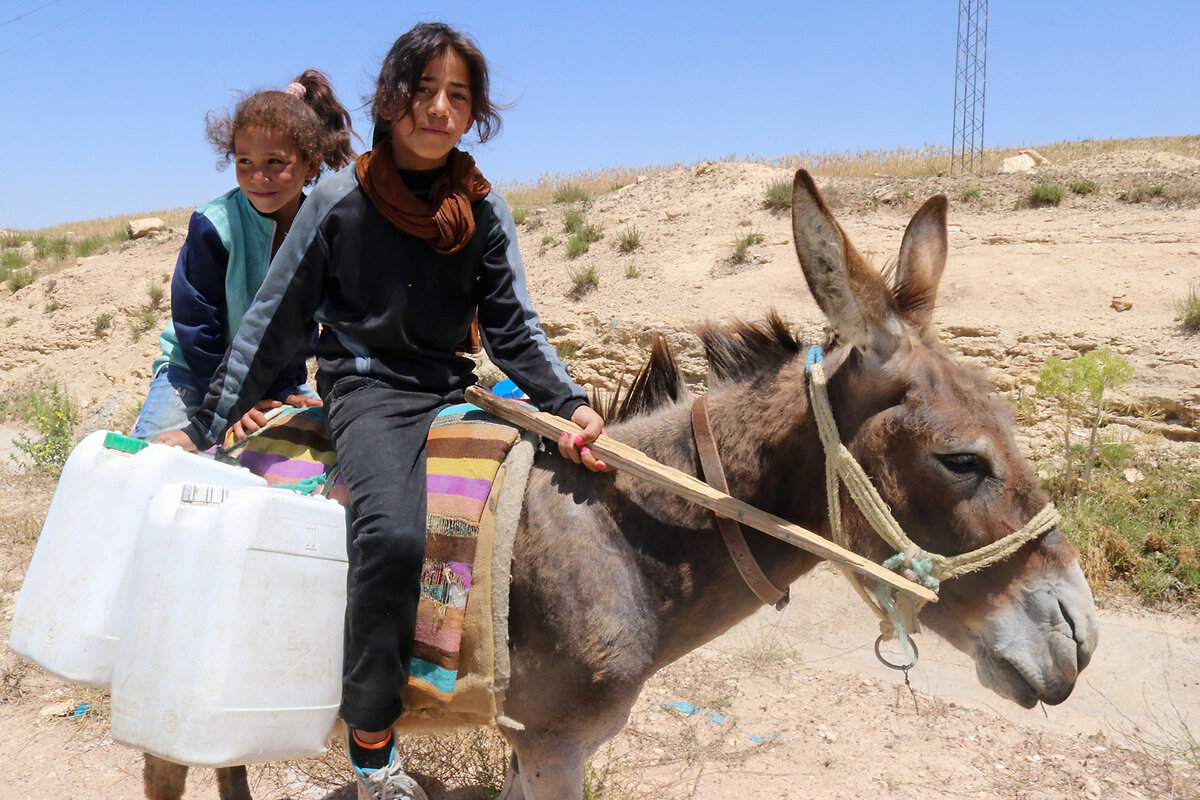
Young Tunisians take their chances in Europe
Seifaldin now spends 10 hours a day working in greenhouses in southern Italy. Sicily’s rolling hills and olive trees, and the brilliant blue Mediterranean sky, remind him of Sisseb – but the work is much harder.
“The place is beautiful, but the work is not,” he says from Sicily.
Still, he stands by his decision to leave.
Only in recent years have international organizations and governments recognized climate and environmental degradation as a factor driving human mobility – especially when it intersects with a lack of effective policy.
“My social situation was good,” Seifaldin says. “But for years, my income declined due to the lack of rain and groundwater.”
A few miles down the road from Sisseb is a village now known as Milano, or Milan.
The town’s real name is Elarfat. But so many younger residents have left this dusty town for Europe, its nickname has stuck. There are middle-aged parents and young children here, and a few older shepherds still living by the rusted, empty water tower, but that’s all.
Mohammed, a shopkeeper selling dry pasta and canned tuna on the side of Milano’s main road, estimates that two-thirds of the young men from 230 families here have left for either the coast or Europe. This includes his own son, who is in Italy.
Mohammed asked to withhold his full name out of fear of angering authorities for speaking to the press about migration.
“If the water finishes,” he says, “maybe only the elders will remain.”
Directly next to Mr. Al Hur’s failed farm in Sisseb, young people sit at outdoor plastic tables, facing dusty fields and nursing espressos. They talk of friends, neighbors, and relatives who have made the trip to Italy and whether they would attempt the dangerous journey themselves.
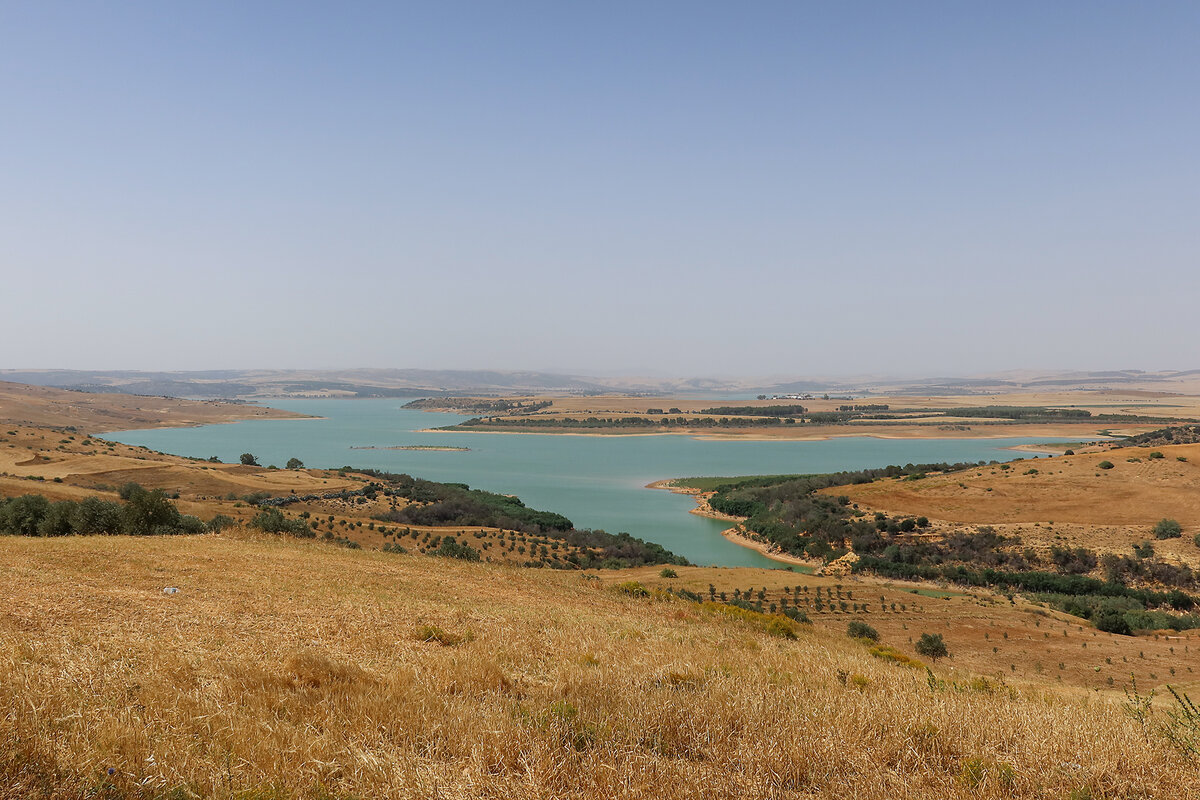
“If I had the money, I would be with them right now,” says one café patron named Hamed. His best friend and his cousin are on their way to the coastal town of Sfax, some 115 miles away, to meet with a smuggler they’ve hired to take them in a dinghy to Italy. This will be their second attempt.
The number of Tunisians migrating to Europe by boat jumped from 2,600 in 2019 to 13,000 in 2020, to 14,000 in 2021, and then to a record high of 18,400 in 2022. In 2023, the number topped 17,400.
Every time Hamed’s phone buzzes, he grabs it, almost jumping, to check the updates.
And every dinar, or 32 cents, the 23-year-old makes gets him a baby step closer to the 8,000 dinars, around $2,500, he needs to take his own chance on the Mediterranean’s choppy waters. He earns money like most men do in this town, by digging illegal wells. It’s an entire economy built on searching for the increasingly scarce drops of water.
According to the research group Arab Barometer, the percentage of Tunisians desiring to migrate has climbed from 22% in 2011, in the wake of the nation’s democratic revolution, to 46% in 2024 – the highest ever recorded in an Arab country.
For Tunisians between the ages of 15 and 29, this rate is 70%.
“Vast swaths of Tunisia are climate-vulnerable, and we can’t say that everyone is a climate migrant if they are moving,” says Lawrence Huang, policy analyst at the Washington-based Migration Policy Institute. But “understanding the way climate change is affecting them is critical so that we can prepare for and help avoid situations of forced displacement.”
“With the impacts of drought and extreme temperatures and rising sea levels, Tunisia is emblematic of global trends,” he says.
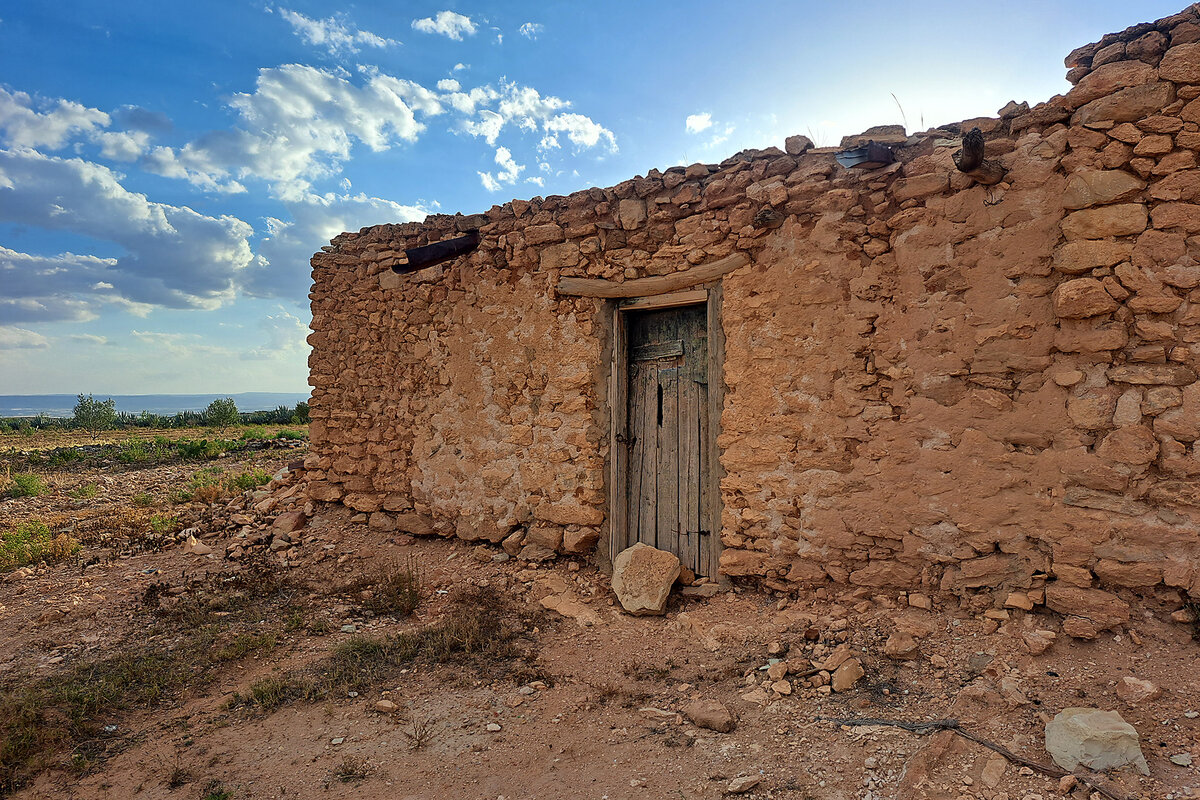
Feeling alone, local officials search for homegrown solutions
Mohammed, the shopkeeper, has tried to help the situation. In December 2023, Mohammed was elected to the area’s local council, as part of a new governing system drawn up by authoritarian President Kais Saied. Mr. Saied, who rode to victory in 2019 on a wave of popular anger over government’s failure to address deteriorating socioeconomic conditions, assumed emergency powers under the guise of pandemic control in 2021.
The strongman president and his supporters pitched local councils as a new way of governing, and as a way to empower local communities and individuals to take part in the decision-making process without having to go through political parties.
Mohammed had plans to revive the water networks and water tower, a project that has been frozen since the 1990s. Yet several months in, the Elarfat council has no budget, no funds, no mandate, and little ties or contact with government ministries and Parliament.
Mr. Saied, who ripped up the 2014 democratic constitution and drew up his own, instead appears to be preoccupied with arresting opponents and critics ahead of November’s presidential elections.
A 2022 Gallup poll showed that 85% of Tunisians were dissatisfied with government efforts to preserve their environment in their country; in 2023 and 2024, Mr. Saied oversaw crackdowns on peaceful environmental protests and locked up campaigners.
“We all have solutions that could help our community, particularly in the water situation,” Mohammed says, “but until now, we are still left on our own.”
As men search for work, women scrape by on failing farms
In Al-Ala, the village Mr. Barqoushi left to find work in Tunis, wealth determines who stays and who leaves.
A well-off family down the road is enjoying a bumper crop of tomatoes and cucumbers, fed by a deep well and water trucked in from outside. Mr. Barqoushi’s wife, Sonia, and her sisters-in-law have resorted to backbreaking work on thriving big commercial farms north of Al-Ala, picking olives or harvesting wheat for $8 a day.
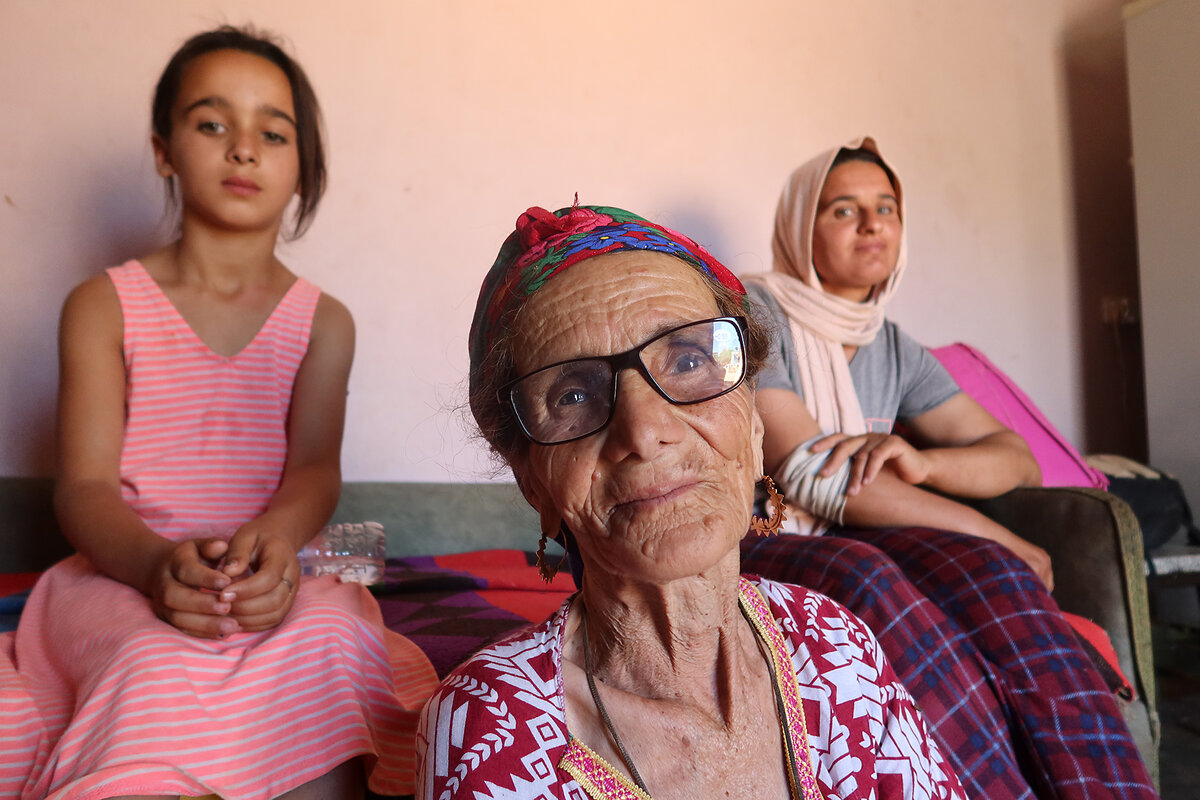
Haves and have-nots in Tunisia are now water-haves and water-have-nots.
Mr. Barqoushi’s home, like most in the village of Al-Ala, is now a women-run household. Ms. Barqoushi cleans, cooks, and does maintenance on the house; helps the children with their schoolwork; tends to the chickens; and checks on the farm while her husband lives and works in the city.
“We have to be mother and father here, all of us,” she says. In Al-Ala, and across central and southern Tunisia, an entire generation of children is growing up barely knowing their fathers. “Thank God for mobile phones; otherwise they would never see their father.”
Ms. Barqoushi keeps the family farm alive – but not producing. The house’s rainwater-cache well, which once stored winter rains for household use throughout the year, now gathers enough water for just two months. During the rest of the year, the family has to bring in a commercial water tanker twice a month to fill its well, at $11 for 500 liters (130 gallons). It uses this water at home and to strategically water the pale-green olive and almond trees on the adjacent farm.
She stops and looks at the adjacent severed trunk of an almond tree that died three months ago.
Mr. Barqoushi’s mother, Ayesha, sits on a cushion, watching her grandchildren with a sad smile. Back when Mr. Barqoushi was growing up, four decades ago, Al-Ala families worked together on the farm and lived in connected houses or plots of land – raising children together, passing on the land from one generation to the next.
Of the matriarch’s five sons, three, including Mr. Barqoushi, work as day laborers in Tunis; the fourth works in construction in the coastal city of Sfax, and the fifth is doing odd jobs on the tourist island of Djerba. Her daughter moved with her husband to the capital.
“The land was generous with us,” Ayesha Barqoushi recounts. “Our entire community was one family. Now our land is thirsty, and we are scattered.”
“I just want to live on my land and be with my family”
While migration to Europe captures the imagination of young Tunisians, the bulk of Tunisian migration remains internal, with cities drawing an increased number of farmers.
“No one would give up farming for that life by choice,” says Issa Idoudi, a local Tunisian farmers union representative. “These people have no money, no options. They were forced out.”

Back in Tunis, Mr. Barqoushi is still loitering in the La Goulette neighborhood waiting for a job – he has been standing there since dawn. Slender and soft-spoken, he struggles to stand out from the row of two dozen rural migrants, also former farmers, who line up offering up their skills. As it reaches 9:30 a.m., he is resigned to the fact there will be no job today. He travels across town to the working-class neighborhood of Mourouj to go “home” – a vegetable stand run by a friend who lets Mr. Barqoushi stay for free so that he can save up money to send back home. Mr. Barqoushi slips in and out when the landlord is not in the area – their arrangement is a secret.
He sleeps in a tiny, 6-foot-by-2-foot space with a cot and a hodgepodge of tarps and curtains dividing it from the tomatoes, melons, and potatoes for sale. His personal belongings – clothes, a couple of books – are stuffed into used shopping bags, which hang from the top of his tent along with three towels and a bunch of dried garlic.
“I don’t want to migrate. I just want to live on my land and be with my family,” he says, sitting on his cot, shrouded in darkness. “Can anyone help us?”
Ahmed Ellali contributed to this report.

Today’s news briefs
• Middle East attacks: United Nations peacekeepers in Lebanon urge immediate de-escalation as hostilities rumble on at the Lebanese-Israeli border, following Israel’s most intense airstrikes in nearly a year of conflict with the Iran-backed Hezbollah.
• Early voting in U.S.: In-person voting for the 2024 U.S. presidential election begins in three states – Virginia, South Dakota, and Minnesota.
• Pennsylvania polls: Vice President Kamala Harris and former President Donald Trump remain deadlocked weeks before the U.S. presidential election, according to new polls that also show a tight race in the key state of Pennsylvania.
• Sri Lanka vote: Sri Lanka’s presidential candidates wrapped up their campaigning this week, pledging to fix the island country’s ailing economy as it struggles to recover from a debilitating financial crisis. The election is Sept. 21.
• Europe flood aid: The European Union will make billions of euros available to help Central Europe recover from severe floods, European Commission President Ursula von der Leyen says.

Why Congress is scrambling over disability benefits for veterans
Congress scrambled to pass an emergency spending bill to ensure veterans continue to receive benefits. Questions linger over why costs are rising so quickly and whether spending is best meeting the needs of veterans.

- Quick Read
- Deep Read ( 5 Min. )
Nearly one-third of U.S. military veterans get disability pay from the Department of Veterans Affairs, an all-time high.
In the past year alone, the volume of new veterans’ compensation claims has “exceeded even our most aggressive projections,” Joshua Jacobs, undersecretary for benefits at the VA, told lawmakers this week.
This surge in spending forced VA officials to go hat in hand to Congress this week, requesting $3 billion for a 2024 budget shortfall. They were granted the money in an emergency spending bill, now headed for President Joe Biden’s desk to be signed into law.
But lawmakers predicted this will not be the last time the department struggles with its ballooning budget. This has been driven by an aging veteran population, rising health care prices, and what are widely agreed to be much-needed improvements to VA facilities, including hospitals.
“Someone who’s put their life on the line for the country deserves tremendous support from our government,” says Mark Duggan, professor of economics at Stanford University. But perhaps there are ways to spend the funds, including for job training and wage subsidies for working vets, that would prove beneficial, he adds.
Why Congress is scrambling over disability benefits for veterans

The United States has been paying benefits to battle-wounded soldiers since the Revolutionary War, but those figures have risen astronomically since the turn of the 21st century.
Today, nearly 30% of military veterans get disability pay from the Department of Veterans Affairs.
In the past year alone, the volume of new veterans’ compensation claims has “exceeded even our most aggressive projections,” Joshua Jacobs, undersecretary for benefits at the VA, told lawmakers this week.
This surge in spending forced VA officials to go hat in hand to Congress this week, requesting $3 billion for a 2024 budget shortfall and a projected $12 billion next year.
They were granted the money Thursday to meet this year’s needs in an emergency spending bill, now headed for President Joe Biden’s desk to be signed into law.
But lawmakers predicted this will not be the last time the department struggles with its ballooning budget, which currently stands at $370 billion.
The veterans population decreased, so why is spending on the rise?
Between 2000 and 2022, the share of veterans in the U.S. decreased by one-third. Yet the VA’s budget nearly tripled during that time. This has been driven by an aging veterans population, rising health care prices, and what are widely agreed to be much-needed improvements to VA facilities, including hospitals.
Democrats, for their part, have decried the growing privatization of some VA health services – known in VA parlance as “community care” – which is also driving up expenses. It’s a shift that began 10 years ago, after long wait times for veterans prompted a public outcry. Private care now accounts for about one-third of the VA’s $150 billion annual health care budget.
Another big driver of the latest soaring VA costs has been a law passed in 2022 called the Promise To Address Comprehensive Toxics, or PACT Act. It provides health care and other benefits for veterans exposed to toxic substances like the jet fuel-ignited pits used to burn plastic water bottles and medical waste, among other things, on U.S. bases during the wars in Iraq and Afghanistan.
Since the PACT Act went into effect, more than 710,000 veterans have enrolled in VA health care – a 34% increase, according to the agency.
The VA spent an average of $14,400 per veteran in 2022, versus $4,300 in 2005, adjusted for inflation, according to USAFacts, a nonprofit that analyzes government data.

How many more vets are getting benefits today than in the past?
Benefit claims are skyrocketing. Today, nearly one-third of America’s 18.5 million veterans – and 40% of post-9/11 vets – get disability pay, notes Mark Duggan, professor of economics at Stanford University.
By way of comparison, from 1954 to 2000, the share of former service members receiving disability payments was stable, generally somewhere between 8% and 10%.
During that same time period, average disability ratings – used to determine benefit dollars – hovered at around 10%.
Today, one-third of veterans have a disability rating of 50% or more, a “spectacular increase,” says Dr. Duggan, who has written about the topic with Lt. Col. Kyle Greenberg, associate economics professor at the U.S. Military Academy at West Point.
This is in part because the VA has expanded medical eligibility criteria to cover a larger category of service-connected injuries, which now include exposure to Agent Orange for Vietnam-era vets, for example, as well as potential secondary effects like diabetes and heart disease.
Disability payments range from some $171 a month tax-free for those with no dependents and a 10% disability rating to $3,738 for those with a 100% rating. They are adjusted up each year for inflation. Vets with families receive higher payments.
Once they’re granted, veterans can and often do apply to have these disability ratings increased – known as being “promoted.”
“The ratings basically never go down. If a condition improves, it’s not like people go back and say, ‘Oh, I’m doing better.’ It doesn’t happen, at least in the time period I looked at the data,” Dr. Duggan says. “It tends to go up.”

Is more money making life better for veterans?
Soaring VA expenses are prompting some analysts to ask whether the VA is using its funds in a way that best helps veterans.
These questions can be sensitive for public officials to tackle. “It’s very difficult to have a conversation about it, because it can very easily unintentionally signal that we sent troops off to do the dirty work and now we’re going back on our commitment as a nation,” says Katherine Kuzminski, director of the Military, Veterans, and Society Program at the Center for a New American Security think tank.
What’s more, up until recently, troops who served for less than 20 years weren’t entitled to retirement benefits, even though, as in the case of Iraq and Afghanistan, they were deploying frequently, she adds. This incentivized some vets to maximize compensation they could claim through other means.
Putting cost aside for a moment, the standard for success should be whether these programs are improving the lives of veterans, analysts say. Research shows, however, that even as benefits increase, veterans’ mental health, as measured by suicide rates, has decreased relative to their peers’.
This in turn risks feeding a “broken veteran narrative” and corresponding concerns among young people, borne out in recent surveys, in which they cite physical injury and psychological distress as top reasons they aren’t joining the military.
At the same time, while service-related wounds may certainly prevent some veterans from working, 20 years ago more veterans overall had jobs, which can support their well-being postservice, analysts say.
What to do about it? One possibility is to make disability benefits, which are currently provided for life, temporary, to be reevaluated periodically for conditions that are more likely to improve.
A recent Congressional Budget Office report also raises the possibility of reducing or eliminating disability compensation for higher-income vets, which the office estimates would save some $250 billion over 10 years.
Government benefits to veterans are provided in the highest spirit of gratitude and care. “Someone who’s put their life on the line for the country deserves tremendous support from our government,” Dr. Duggan says. But perhaps there are ways to spend the funds, including for job training and wage subsidies for working vets, that would prove more beneficial, he adds. “I think it’s a fair question to ask.”

GOP mayor talks about border, why he supports Harris
Some prominent Republicans have endorsed Democrat Kamala Harris in her quest for the presidency. John Giles, a conservative mayor in a border state, says it’s about moving beyond party affiliations and working in “the middle.’’

- Quick Read
- Deep Read ( 6 Min. )
You may have seen John Giles, a lifelong Republican and the mayor of Mesa, Arizona, speak at the Democratic National Convention in August. He leads a conservative city in a key swing state, but is opposing GOP nominee Donald Trump and endorsing Democrat Kamala Harris for president.
Other prominent Republicans have endorsed Ms. Harris, including former GOP Rep. Liz Cheney, former Vice President Dick Cheney (Ms. Cheney’s father), and former U.S. Attorney General Alberto Gonzales. More than 100 former GOP officials, including some from the Trump administration, endorsed Ms. Harris in a letter this week.
Similar defections are notably absent on the other side, though ex-Democrats Robert F. Kennedy Jr. and former Rep. Tulsi Gabbard have joined Mr. Trump’s team. The Harris campaign is hoping conservative endorsements will help win over wavering Republicans and independents.
“I think she’s going to govern from the center, which I’m OK with,” Mr. Giles says in explaining his decision. “Compromise is part of government, and she’s demonstrated an ability to do that.”
GOP mayor talks about border, why he supports Harris
You may have seen John Giles, a lifelong Republican and the mayor of Mesa, Arizona, speak at the Democratic National Convention in August. He leads a conservative city in a key swing state, but he is opposing GOP nominee Donald Trump and endorsing Democrat Kamala Harris for president.
Other prominent Republicans have endorsed Ms. Harris, including former GOP Rep. Liz Cheney, former Vice President Dick Cheney (Ms. Cheney’s father), and former U.S. Attorney General Alberto Gonzales. More than 100 former GOP officials, including some from the Trump administration, also endorsed Ms. Harris in a letter this week.
Similar defections are notably absent on the other side, though ex-Democrats Robert F. Kennedy Jr. and former Rep. Tulsi Gabbard have joined Mr. Trump’s team. The powerful Teamsters union – amid strong membership support for the former president – decided not to endorse either candidate this year. The Harris campaign is hoping conservative endorsements will help win over wavering Republicans and independents.
The Monitor sat down with Mr. Giles earlier this month in his City Hall office in Mesa, near Phoenix. With a panoramic view of Camelback Mountain as a backdrop, he talked about why he’s endorsing the vice president and how he squares that with his Republican and religious values. Like many in Mesa, he’s a member of The Church of Jesus Christ of Latter-day Saints. “I think she’s going to govern from the center, which I’m OK with,” he says. “Compromise is part of government, and she’s demonstrated an ability to do that.”
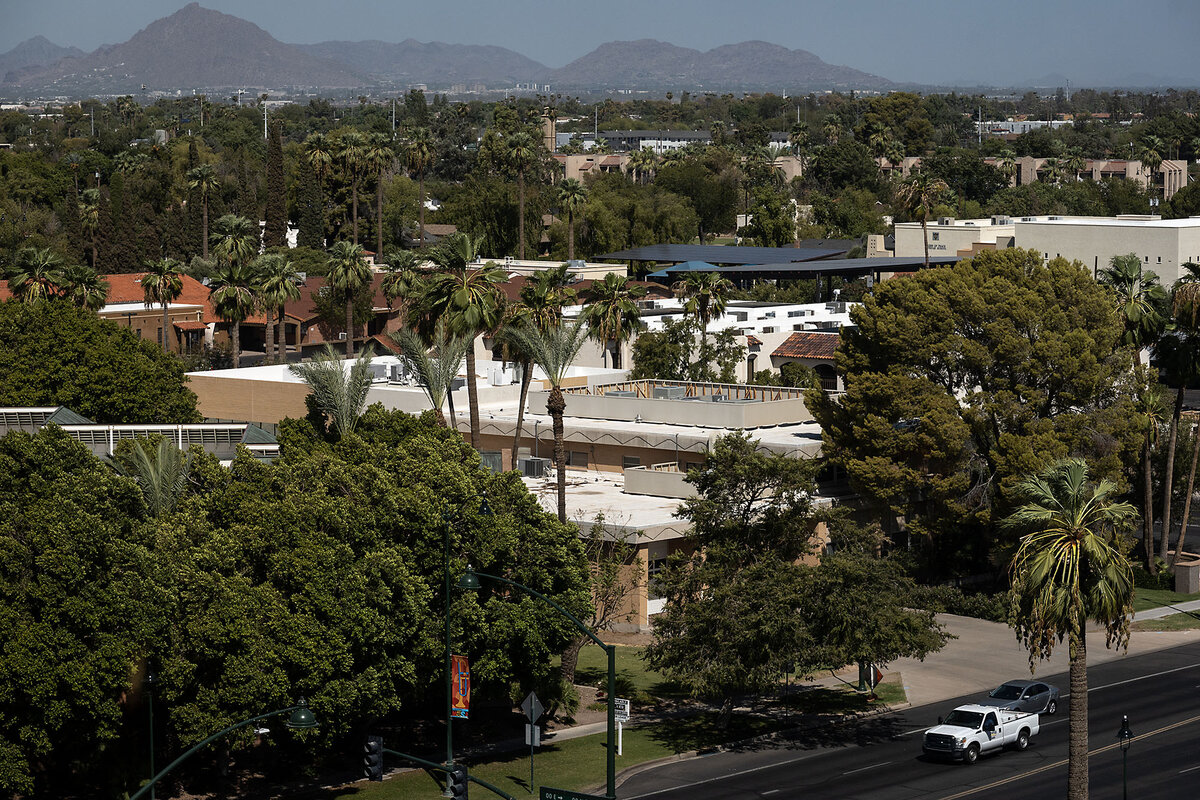
The following interview has been condensed and lightly edited for clarity:
Why are you endorsing Kamala Harris?
I need to back up a bit. I’ve been the mayor of my hometown for the last 10 years, and I have loved this job. And part of what I’ve loved is that I’m elected in a nonpartisan election, and I lead a city council that is diverse and made up of progressive Democrats and conservative Republicans. We get along amazingly well. And that’s because we don’t bring partisanship to the equation. We focus on the middle, and we take a problem-solving approach.
I wade into partisan waters only very rarely, but I’m compelled to take a side in this presidential campaign because a second Donald Trump presidency would not be in the best interest of my city. Donald Trump made a lot of promises. None of them came true.
Can you delve into that?
Infrastructure is a huge issue for us. Under President Trump, “Infrastructure Week” became a running gag. Literally nothing occurred as far as federal participation in helping with infrastructure.
During the Biden administration, we’ve had the Chips Act, which has had this dramatic impact in the Phoenix area. TSMC [Taiwan Semiconductor Manufacturing Co.], Intel, both are making multibillion-dollar investments in chip fabrication facilities. A lot of the supply chain economy that supports those fabs is in Mesa. Taiwan Semiconductor is literally making the largest foreign investment in the history of the United States here in Arizona. That’s because of the Chips Act, where there’s federal funds involved. These investments will have a generational impact. So the Biden administration deserves credit for that.
Similarly, the Bipartisan Infrastructure Act – that’s had a significant impact in Mesa, particularly out of our airport. We got a new terminal and a new air traffic control tower.
I want to ask about your own personal journey in this switch. Was there a turning point for you?
It’s been death by a thousand cuts. For the last several years, I’ve walked into the office and asked my staff, “Can I leave the Republican Party now?’’ But I came to the conclusion that it would be a mistake to do that.
I continue to be in the Republican Party because I really do identify more with Republican principles and the Republican emphasis on personal responsibility and smaller government. I think it’s important that voices like mine don’t leave the party but continue to point out its flaws in hopes of a system where we have two strong parties.
The Republican Party might be a lost cause. But having multiple strong parties is a cause that’s worth fighting for. It’s still important that there be loyal opposition in the Republican Party.
How much blowback have you gotten?
Any time you’re in national media and you say something provocative, you’re going to get hundreds of emails comparing you to a little brown emoji. I was censured two years ago by the local Republican Party, and I’ve been censured again. I fully expected all that. What I’ve been more taken aback by is the positive reaction that I’ve gotten from strangers who walk up to me and say, “You don’t know me, but I’ve seen what you’ve said. Thank you for giving a voice to what I’ve been feeling for the last few years.”
How do you square your conservative values with what Ms. Harris stands for?
Vice President Harris is very different from the candidate that she was four years ago. The experience that she’s had in the White House has taught her the importance of governing from the middle. I am not afraid of a Harris administration coming in and being this hair-on-fire, progressive administration that the Trump campaign is painting it to be.
The bipartisan immigration and border bill was very much a compromise. It was green-lit by Senate Republican leader Mitch McConnell. And if the votes were there, that was going to happen. Until Donald Trump decided that it was not in his best interests.
Kamala Harris has already said she would sign that. To me, that’s an indication that she’s pragmatic.
The same is true of her economic policies. They’re focused on food inflation, on housing affordability and availability, on real-life, Middle America problems. It’s not a socialist agenda.
Donald Trump’s economic policies are troubling because he’s going to double tariffs. I don’t think that’s a very Republican policy. He’s going to create housing supply by deporting millions of people. I don’t think that’s a smart policy that economists and Republicans would endorse.
Mesa has a lot of members of The Church of Jesus Christ of Latter-day Saints, to which you also belong. Do your LDS values inform your politics?
For many years, people like myself have been taught in church: “Hey, it’s okay to be a Democrat. It’s okay to be a Republican. Sometimes you need to zigzag between the two.” But there’s been an underlying, maybe less-said, emphasis on, really, you can’t be a Democrat because of abortion.
Now that Donald Trump has been successful in overturning Roe and in turning abortion from a federal issue to a state issue, there’s no longer a need for people in my religious community, who felt duty-bound not to vote Democratic, for any loyalty to the Republican Party on the abortion issue. Of course Kamala Harris is pro-choice, but do you think there’s going to be 60 votes in the Senate for a national abortion bill? That hasn’t happened in 250 years. It’s not going to happen now.
You chair the immigration task force for the U.S. Conference of Mayors. Do you see a way forward on immigration?
The short-term solution is that Donald Trump needs to lose this election, because he’s going to continue to use the issue for political purposes. With that mindset in the White House, nothing is going to happen. Kamala Harris has already said that if she is elected, she will pick up where we left off with the bipartisan border bill.
Executive orders can in some marginal ways impact the number of border crossers. Donald Trump, on this issue, was fortunate to be president during the pandemic, because under Title 42 he could use the pandemic as an excuse to put limitations on border crossers. But executive orders are no substitute for congressional action.
If we just separate the political gamesmanship from it, immigration is very solvable.
But when we have things like, at the Republican convention, chanting for “mass deportation now,” that’s not helpful. Arizona is a great example of that. When we had SB 1070 – where the state got involved in enforcing federal immigration laws – it was devastating to our economy.
The tradespeople, the skilled workers, were predominantly immigrants. And when the state pulled people over for “driving while brown,” that had a chilling effect on the Hispanic community, and they left.
What difference do you think Republicans for Harris will make?
It will make a difference because, in Arizona, we are a very closely divided state. Joe Biden won the state by about 10,000 votes. The middle is going to decide this. And so moderate Republicans, moderate Democrats, independents, former Republicans – that’s the battleground within the battleground state.

Podcast
Smartphones at school: Inside a not-so-simple debate
It’s often yet another binary battle: Cellphones at school are either out-and-out distractions that drag down learning or they’re needed tools, and lifelines in emergencies. Two Monitor writers set out to explore the middle, then joined our podcast to discuss the assignment.

Smartphones in hand, all of the time, and pretty much everywhere.
That has largely become a social norm in the United States and Canada. Can we expect different behavior from, say, young teens at school?
Turns out, this is more than a story of enforcement, by parents or schools. It’s partly about seeing cause and effect, and adapting. The Monitor’s Jackie Valley and Sara Miller Llana recently co-wrote a Monitor Weekly cover story on the subject.
“What we found through this reporting is that when kids were presented with the opportunity to take a social media break, whether because they were forced to or encouraged [to], they saw the benefits,” says Jackie on our “Why We Wrote This” podcast.
And parents? Many work to keep their children from the clutches of too much social media. But a school shooting can change that. The phone becomes an indispensable means of contact.
Solutions come hard. What might matter most: A problem is getting attention.
“I actually feel so much better about the whole situation after reporting this,” says Sara. “Because we weren’t even having this conversation a couple of years ago.” – Clayton Collins and Jingnan Peng
Find story links and a transcript here.
A Fight Over Students’ Phones

In Pictures
Old cars race loud and proud
Historic sports cars exude an allure that is second only to the thrill of watching them compete. Fans at Watkins Glen International track can’t get enough of races featuring these magnificent machines.

- Quick Read
- Deep Read ( 2 Min. )
Racing old cars is a loud, and dangerous, sport.
I am walking to a spot at the Watkins Glen International track where I can take a photo when a truck comes by towing a Porsche with a smashed-in front end. The driver is sitting in his seat looking pitifully embarrassed, but at least he isn’t injured. I have permission to stand by the blue guardrail that surrounds the track – just not at certain curves that are especially prone to accidents, and not too close. No problem!
Racing fan John Kwasnowski is taking photos in the pit. Racing “gets in your blood,” he says. “If you love it, you can’t get enough.”
Historic Sportscar Racing staff member Frank Thompson, who lines up the cars in qualifying order before a race, notes that “We’re a traveling family. ... We spend more time with this family than with our real one.”
He has more to say. If only I could hear him above the roar of the engines.
Expand the story to see the full photo essay.
Old cars race loud and proud
The sound comes first. I’m driving through the rolling hills of dairies and farmland in New York’s peaceful Finger Lakes area when I begin to hear something that doesn’t belong. Race cars! I had been warned to bring earplugs, but I had no idea how loud LOUD could be. The noise, like a herd of Harleys, vibrates in my body. I arrive at Watkins Glen International, a 3.45-mile track that hosts Historic Sportscar Racing (HSR) events and other races.
Although almost all of the drivers are amateurs, they are credentialed. But this is a dangerous, and very expensive, sport. I am walking to a spot where I can take a photo when a truck comes by towing a Porsche with a smashed-in front end. The driver is sitting in his seat looking pitifully embarrassed, but at least he isn’t injured. I have permission to stand by the blue guardrail that surrounds the track – just not at certain curves that are especially prone to accidents, and not too close. No problem!
Racing fan John Kwasnowski is taking photos in the pit. Racing “gets in your blood,” he says. “If you love it, you can’t get enough.”
HSR staff member Frank Thompson, who lines up the cars in qualifying order before a race, notes that “We’re a traveling family. ... We spend more time with this family than with our real one.”
He has more to say. If only I could hear him.



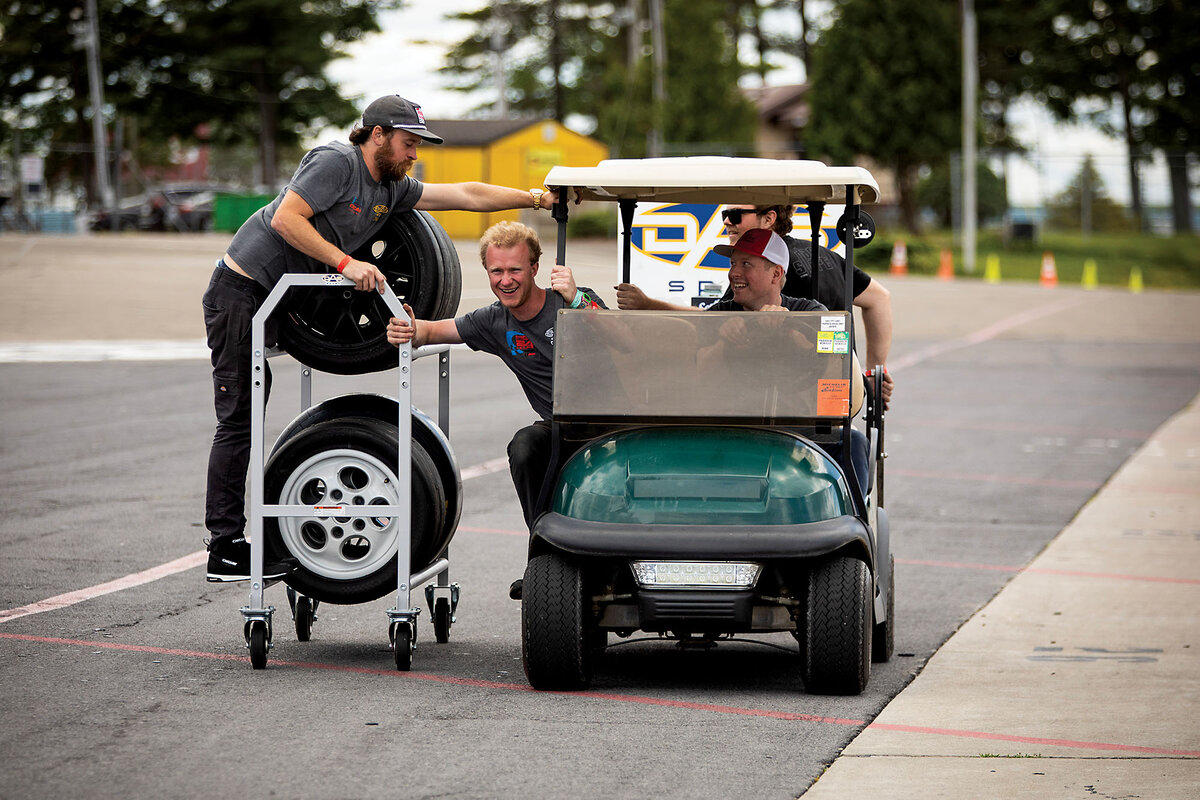
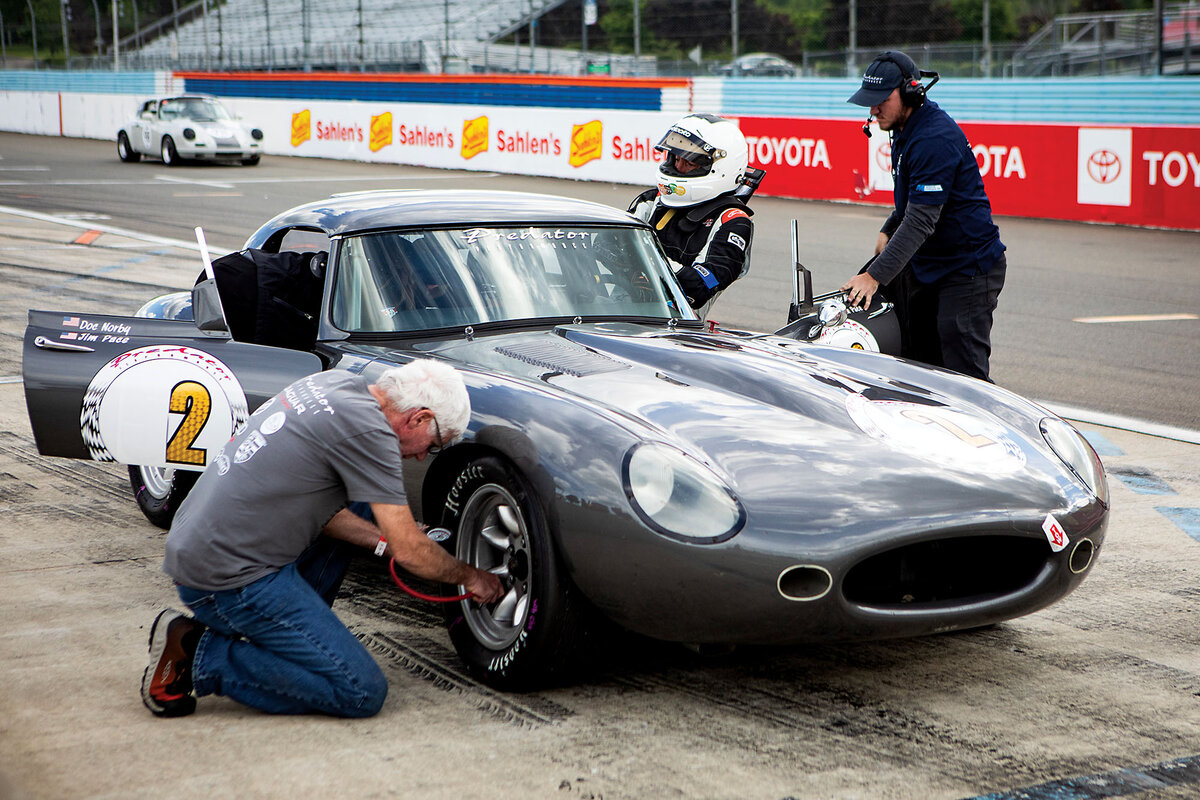

For more visual storytelling that captures communities, traditions, and cultures around the globe, visit The World in Pictures.
Other headline stories we’re watching
(Get live updates throughout the day.)The Monitor's View
Pro athletes as star exemplars
- Quick Read
- Deep Read ( 2 Min. )
-
By the Monitor's Editorial Board
As games, basketball and baseball have little in common other than they both involve a ball. It is possible that Caitlin Clark and Shohei Ohtani don’t share many fans. Yet the people packing stadiums to watch these two athletes in motion may be drawn for similar reasons.
On Thursday, on a baseball field in Miami, Shohei Ohtani became the first player in pro ball history to hit 50 home runs and steal 50 bases in a single season. In women’s basketball, meanwhile, Ms. Clark has notched her own unique impact. In her rookie year, the Indiana Fever guard set more than 20 league or franchise records. Among them: most assists in a single game, most 15-point/five-assist games in a season, and most assists in a single Women’s National Basketball Association season.
Among basketball fans, the most passionate debate is not over who was the greatest player but over who was the greatest passer. “It’s the selfless stars who shine the brightest and who never fade with time,” observed Walt Rakowich, who writes on leadership.
When players dazzle with the ball, they also draw fans through the quieter qualities of excellence.
Pro athletes as star exemplars

As games, basketball and baseball have little in common other than they both involve a ball. It is possible that Caitlin Clark and Shohei Ohtani don’t share many fans. Yet the people packing stadiums to watch these two athletes in motion may be drawn for similar reasons.
On Thursday, on a baseball field in Miami, Shohei Ohtani put up one of the greatest performances ever seen in a single game: six hits in six at bats, three home runs, two stolen bases, and 10 runs batted in. All of that merely marked the final footsteps to a stat-shattering achievement: In the same game he became the first player in pro ball history to hit 50 home runs and steal 50 bases in a single season. Before Mr. Ohtani, who plays for the Los Angeles Dodgers, only five players had ever notched 40 and 40.
In women’s basketball, meanwhile, Ms. Clark has notched her own unique impact. In her rookie year, the Indiana Fever guard set more than 20 league or franchise records. Among them: most assists in a single game, most 15-point/five-assist games in a season, and most assists in a single Women’s National Basketball Association season.
All that “assisting” explains why women’s basketball is rapidly gaining popularity. “Teamwork. It’s unselfish play,” Diane Devor, a Fever fan, told the Martinsville Reporter-Times, an Indiana newspaper. “They look for the opening and then they share the ball. They spread the love.”
In a postgame interview after she scored 31 points in a recent matchup, Ms. Clark used the word “we” 13 times in less than 30 seconds, according to USA Today.
Despite the celebrity status of elite professional athletes, many fans are more apt to cite the qualities of character that they relate to in their favorite players than the unicorn abilities they have with the ball.
In Mr. Ohtani’s home country of Japan on Thursday, fans reacted to his record-breaking day with gratitude. Some recalled how he cleaned public bathrooms in high school to help the family finances. His new record honored what Japanese fans value in baseball, such as perseverance, discipline, and humility.
Among basketball fans, the most passionate debate is not over who was the greatest player but over who was the greatest passer. “It’s the selfless stars who shine the brightest and who never fade with time,” observed Walt Rakowich, who writes on leadership. He was writing about Nikola Jokić, the MVP in last year’s NBA championships honored for his “humble, team-first approach to the game.”
When players dazzle with the ball, they draw fans through selfless qualities as much as through athletic excellence.

A Christian Science Perspective
Each weekday, the Monitor includes one clearly labeled religious article offering spiritual insight on contemporary issues, including the news. The publication – in its various forms – is produced for anyone who cares about the progress of the human endeavor around the world and seeks news reported with compassion, intelligence, and an essentially constructive lens. For many, that caring has religious roots. For many, it does not. The Monitor has always embraced both audiences. The Monitor is owned by a church – The First Church of Christ, Scientist, in Boston – whose founder was concerned with both the state of the world and the quality of available news.
‘God, our refuge, strength and stay’

- Quick Read
- Read or Listen ( 1 Min. )
Even when hatred has grown to a violent extreme, we can turn to God as Love and find the safety we need.
‘God, our refuge, strength and stay’
God is our refuge and strength, a very present help in trouble. Therefore will not we fear.
– Psalms 46:1, 2
Clad in the panoply of Love, human hatred cannot reach you.
– Mary Baker Eddy, “Science and Health with Key to the Scriptures,” p. 571
Everlasting arms of Love
Are beneath, around, above;
God it is who bears us on,
His the arm we lean upon.
He our ever-present guide
Faithful is, whate’er betide;
Gladly then we journey on,
With His arm to lean upon.
From earth’s fears and vain alarms
Safe in His encircling arms,
He will keep us all the way,
God, our refuge, strength and stay.
– John R. Macduff, “Christian Science Hymnal,” No. 53, adapt. © CSBD

Viewfinder
Misty morning

A look ahead
Thanks for joining us today. On Monday, we’ll look at Nebraska, where the Supreme Court heard arguments this week on whether a recently passed law allowing former felons to vote violates the state’s constitution. Twenty-six states and the District of Columbia now allow former felons to vote – but challenges to those laws are cropping up.


